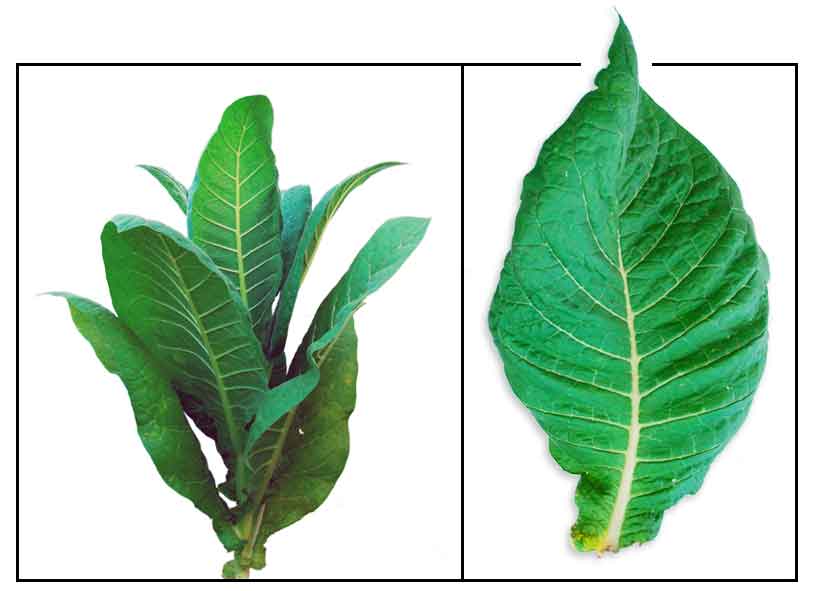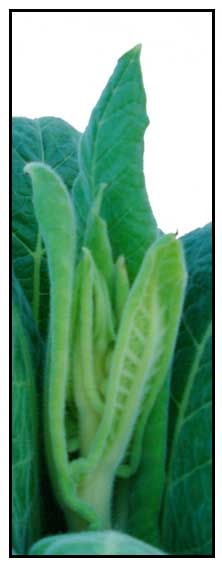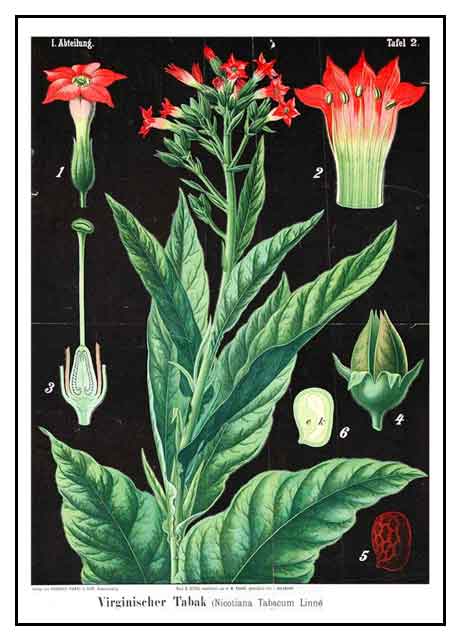Botany
Tabako is a coarse, erect, viscidly-hairy annual herb growing to a height of 0.7 to 1.5 meters. Leaves are large, elliptic-ovate to oblong or obovate, 10 to 30 centimeters long or longer, narrowed by the base, and sessile or short-stalked. Inflorescences are terminal. Calyx is green, ovoid or tubular, 1 to 1.5 centimeters long, with five triangular lanceolate teeth. Corolla is white and pink, linear, funnel-shaped and about 5 centimeters long. Capsule is ovoid, 1.5 to 2 centimeters long, with very numerous white seeds.
 Distribution Distribution
- Cultivated throughout the Philippines.
- A major commercial crop in some provinces.
- Native of tropical America.
- Now planted in all warm countries.
 Constituents Constituents
• Leaves contain active principles, the toxic alkaloid nicotine (0.6 to 9 %) and three other alkaloids: nicoteine, nicotelline, and nicotinine. Also yields
anabasine, betaine iamylamine, pyrrolidine, and n-methyl pyrroline, resin, albumen, gum, extractive matter, and ash containing large amounts of salts (sulphates, nitrates, chlorides, phosphates, malates, and citrates of potassium, ammonium, calcium, etc.)
• Study isolated a pair of sesquiterpene glucosides - 3-hydroxysolavetivone-beta-D-glucoside A and B - from the leaves.
• Seeds of N. tabacum yielded 30% oil, the rest are protein, crude fiber, carbohydrate and inorganic material. Main triglycerides in the seed oil are trilinolein and palmitodilinolein, accounting for about 90% of the oil composition. Major individual fatty acids are linoleic acid (66-76%) oleic acid (17-27%), palmitic acid (7-10%), and stearic acid (3.1%). Oil is classified as linoleic oil in the semi-drying oil category. (21)
Properties
• Except for the ripe seeds, all parts are considered poisonous.
• Leaves considered antispasmodic, discutient, diuretic, emetic, expectorant, narcotic, sedative, maturative, styptic and sialagogue.
Pharmacokinetic factoids
• The nicotine alkaloid is rapidly absorbed from all mucous membranes, lungs and skin, but more commonly enters through the lung alveoli, quickly reaching the heart and brain receptors, and largely eliminated by oxidation through the liver (80 to 90%), a small amount metabolized in the kidneys and lungs. Elimination half-life is 2 hours.
• Nicotine is the primary psychoactive constituent of tobacco – cigarettes, chewing tobacco, and nicotine patches, gum, inhalers and sprays.
• It acts on the autonomic ganglia. One cigarette causes a 50% rise of noradrenaline and 15% rise of adrenaline. From the posterior pituitary, vasopressin is released.
• A pack per day smoking increases the coronary heart disease and myocardial infarction three-fold. There is also an increase in emphysematous lung disease, lung cancer, peripheral vascular disease and stomach ulcers. In women who smoke, there is a higher incidence of premature births, deformities and perinatal infant mortality.
• Used by herbalists as a relaxant, it has long been abandoned because of its highly addictive nature.
Parts
utilized
Leaves
Uses
Folkloric
• In the Philippines, fresh leaves used as poultices as sedative and maturative.
• Decoction of dried leaves used in enemas for expelling certain intestinal worms.
• Dried leaves used as styptic.
• Juice of leaves is sedative, antispasmodic and a powerful insecticide.
• Dried leaves are nauseating, emetic, sometimes purgative.
• Has been used for coughs, whooping cough, hiccups, spasmodic laryngitis, asthmas.
• Tobacco snuff has been used for headache, giddiness and fainting.
• Leaves applied to the abdomen in colic and gripes.
• The ashes, mixed with oil, are applied to bleeding sores.
• Leaves have been used for pain and rheumatic swelling, syphilitic nodes and skin diseases.
Other uses
• Used extensively in agricultural and horticultural applications, for fumigating, spraying, as worm powders, insecticides.
Medical Use in History
• In Europe, first reported as a remedy for wound healing and headaches by Jean Nicot Sieur de Villemain (1530-1600)
• Reported as curative for skin ailmentsw, goiter, broken limes, headaches, ulcers, worms, syphilis and dropsy by Jean Liebault (1536-1596).
• Nicolas Monardes of Spain advocated its used as an enema and tobacco syrup for asthma and coughs.
• From the 16th to the end of the 19th century it was a highly valued herbal curative for a variety of ailments.
 Studies Studies
• Anthelmintic:
Study of methanol and aqueous extracts of Nicotiana tabacum exhibited dose-dependent anthelmintic activity both in vitro and in vivo, justifying its use in traditional medicine in Pakistan. (1) Study evaluated the in-vitro anthelmintic effect of aqueous and alcoholic extract of N. tabacum against M. marshalli. Results showed considerable anthelmintic activity with more potent effects observed with highest concentrations. (18)
• Hematologic Effects:
Study of the aqueous extract of N tabacum leaves showed significant decrease in RBC count, PCV, Hb and platelet count with increase in MCV and MCH. Results suggest the consumption of the aqueous extract of N tabacum may lead to some level of anemia despite its "pleasant effects." (4)
• Lipid Studies / Seed Oils:
Plant lipids find application not only in nutrition, but also in the production of lotions, ointments and various pharmaceutical preparations. ipids Seeds of N. tabacum and N. rustica were found to contain lipids 41.3% and 36.6% respectively. The lipid class in N. tabacum were hydrocarbons (1.4%), wax esters (1.7%) sterol esters (2.4%), triacylglycerols (69.3%), free fatty acids (6.2%), l,3-diacylglycerols (4.6%), l,2-diacylglycerols (3.5%), free sterols (2.3%), 2-monoacylglycerols (2.1%), 1-monoacylglycerols (1.8%), phosphatidylethanolamines (1.7%), phosphatidylcholines (0.9%), Iysophosphatidylethanolamines (1.5%) and phosphatidylinositols (0.6%). (7)
• Antimicrobial:
In vitro antibacterial screening of various extracts of N. tabacum revealed different ranges of antibacterial activities. An ethyl acetate extract was more effective in controlling Bacillus cereus and Erwinia carotovora followed by a butanol extract against Staph aureus and Agrobacterium tumefaciens. (8)
• Biotechnological Reduction of Tobacco Toxicity:
Genetic engineering can modify nicotine levels of the tobacco plant. In the study, through transferring of the blocking gene, the pathway of nicotine biosynthesis was block to produce transgenic tobacco with love levels of nicotine. Lower nicotine levels can reduce toxic effects and facilitate withdrawl from it. (10)
• Review of Properties and Pharmacological Activities:
Tobacco has yielded a spectrum of chemical compounds including nicotine, solanesol, malic, and citric acid. Pharmacologic activities are described i.e., antibacterial, antinociceptive, antimicrobial, antifungal, anthelmintic, CNS activity, and anti-Alzheimer's activity. Review suggest the potential for use of nicotine in the treatment of Alzheimer disease, Parkinson disease, depression and anxiety, schizophrenia, ADHD, pain and obesity. (11)
• Hypoglycemic / Leaves:
Study evaluated leaf extracts of N. tabacum leaves for in vitro inhibition of α-amylase and α-glucosidase. The aqueous extract of plant was most effective as inhibitor (non-competitive) of α-amylase (IC50 5.70 mg/ml) while the acetone extract exhibited best inhibitory (competitive) potential of α-glucosidase (IC50 4.50 mg/mL). Observed inhibitions of α-amylase and α-glucosidase suggest leaf extracts may be useful in the management of diabetes. (14)
• Anti-Aphthous / Mouthwash / Leaves: A randomized double-blinded placebo-controlled clinical trial evaluated the effects of application of tobacco or placebo mouthwash on minor recurrent aphthous stomatitis. Ulcer pain score was decreased by 79.2% and 93.8% and ulcer size was reduced by 69.1% and 92.2%, significantly greater than control group. Results showed decoction prepared from NT leaves used as mouthwash was well-tolerated and safe, and can be used for the management of recurrent aphthous. (15)
• Cytotoxic and Cytogenetic Effects / RD and L20B Cell Lines: Study evaluated the cytotoxicity of aqueous and methanol crude extracts of locally N. tabacum leaves on two cell lines, Rhabdomyosarcoma (RD) tumor cel line and Murine fibroblast (L20B) cell line in vitro. Both extracts showed cytotoxic effect against both RD and L20B cell lines, with a significant decrease in proliferation in RD tumor cell line. The cytogenetic effects of methanolic crude extract of leaves revealed a significant decrease in MJ (mitotic index) in both cell lines. (16)
• Anti-Dandruff / Leaves: Study evaluated the in-vitro anti-dandruff activity of biotransformed material of Nicotiana tabacum leaves using strain of Malassezia (Pityrosporum) furfur. Microbial biotransformed Nicotiana tabacum leaves showed potential anti-dandruff activity between 100 mg/ml to 500 mg/ml, compared with aqueous extract,marketed ayurvedic, homeopathic and allopathic (ketoconazole) formulations. (17)
• N. tabacum Agglutinin Against Lepidopteran Pest Insects: A jasmonate-inducible lectin called N. tabacum agglutinin or NICTABA was found in tobacco (N. tabacum cv Samsun) leaves. Study evaluated the entomotoxic properties of NICTABA against Lepidopterean larvae. Results showed NICTABA can help tobacco plants to counteract caterpillar attacks. (19)
Availability
- Wild-crafted. |

![]()

